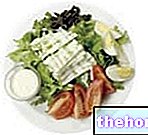PREFACE
The dietary examples presented in this section of the site are largely based on simple foods and not on elaborate dishes or demanding recipes.
Given that these diets are not intended in any way to replace the opinion of a doctor, other health professionals or professionals in the sector, they have in any case been carried out following the most important guidelines on the subject. In particular, great attention has been paid to the contribution of some important nutrients such as:
dietary fiber (20-35 g / day)
cholesterol (less than 300 mg / day)
iron (10 mg for adult males to 18 mg for women of childbearing age)
calcium (1000-1200 milligrams for adults up to 1500 mg in the postmenopausal period)
These limits, of course, are all the more difficult to achieve the more a diet is poor in nutrients such as, for example, the 1400 or 1600 calorie one.

Vitamin intakes have not been specifically analyzed and transcribed since they are normally satisfied by a varied and balanced diet like the one we have tried to offer you.
As for the energy distribution of macronutrients, we have followed a 50:30:20 ratio between carbohydrates, fats and proteins as a guideline. These values differ slightly from the classic ones of the Mediterranean diet (60:25:15) but in the light of the latest research in the dietary and nutritional field they certainly appear more correct.
As regards the quality and origin of the various nutrients, the substitution of meat with fish or legumes was encouraged (at least three times a week) and the moderation of saturated (animal) fats in favor of vegetable ones (olive oil and seeds).
Notes and Advice
Grilling food is a controversial cooking method. It would in fact be considered healthy were it not for those small dark lines that form on the surface of the food (these "scorched" parts are rich in carcinogenic substances).
Since grilling is often present in the proposed diets, it is important to have flat-bottomed grills (special non-stick pans without the classic "lines"). It is also important to avoid cooking food with a flame that is too high.
Since it is the fats that undergo the most important alterations, remember that it is good to oil dishes only after cooking.
As mentioned in the introductory part, the diets were drawn up by preferring simple foods to elaborate recipes and dishes. This strategy was adopted to make the diet richer and reduce the time for preparing meals.
However, such a dietary approach could be difficult to apply for those used to juggling sandwiches, fast food and restaurants. However, we reiterate the need to dose the various nutrients with a certain precision, in order to make the diet more precise, effective and balanced.
So beware of "useless" calories such as alcohol (aperitifs), candies, various snacks (happy hour) and sugary drinks. It is also very important to dose food correctly (see FAQ section at the bottom of the page); small mistakes (for example in the dosage of olive oil) can be very expensive (10g more oil = 90 calories)
To make the dishes more pleasant you can make free use of lemon, vinegar, garlic, spices and various aromas.
Beware of yogurt! When "fruit-flavored" is not specified, it is imperative to consume "natural" yogurt. In fact, the addition of fruit and sugar tends to greatly increase the caloric power of the food.
Frequent questions
- How many calories do i need?
Fast calculation method, indicative and not 100% accurate
FOR SEDENTARY PEOPLE: weight (kg) x 31 = daily calorie requirement
FOR MODERATELY ACTIVE PEOPLE: weight (kg) x 38 = daily calorie requirement
FOR ACTIVE PEOPLE: weight (kg) x 44 = daily calorie requirement
LEGEND: moderately active at least three or four aerobic training sessions per week; active at least five aerobic training sessions
To more accurately calculate the calories you need, see: calorie calculation
- How much does a medium-sized apple weigh? About 200 g
- How much does a banana weigh? About 150-200 grams (with peel), half without peel
- How much does a chicken egg weigh? About 60 grams
- What is 10 grams of dried fruit? Considering the peeled fruit 10 grams = 2 walnuts or 6 almonds or 8-10 hazelnuts
- How much does a medium sized kiwi weigh? 75-125 g
- How much water a day? At least 30 ml per kg of body weight (1 and a half liters for a normal weight person of 50kg, 3 liters for a normal weight person of 100kg); however, higher intakes are recommended, especially for those who practice physical activity
- Can I replace one food with another?
In each diet, for each individual food, the exact grams have been specified, only in this way is it possible to accurately dose the calories and the various nutrients.
The disadvantage of such an approach lies in the constraint of the weight, in fact small variations would be enough to make the calories rise in an instant, passing, for example, from 1500 to 2000. Since it is very easy to run into such errors, it is good to avoid making too many substitutions (rye bread has far fewer calories than traditional as well as partially skimmed milk yogurt has far fewer than fruit; vegetables can be managed with some peace of mind by replacing them with your favorite one; maximum attention in the consumption of olive oil 10 grams = 1 tablespoon, with butter and condiments in general). See also: "unnecessary calories"




























